PRINCETON, NJ -- Since Barack Obama clinched the Democratic nomination and moved into a front-running position for the general presidential election in early June, he has seen his standing versus John McCain improve among voters in red states, blue states, and competitive (or purple) states. Obama has gained at least 3 points in the Obama-McCain gap in all three state groupings compared with voter sentiments in March through May.
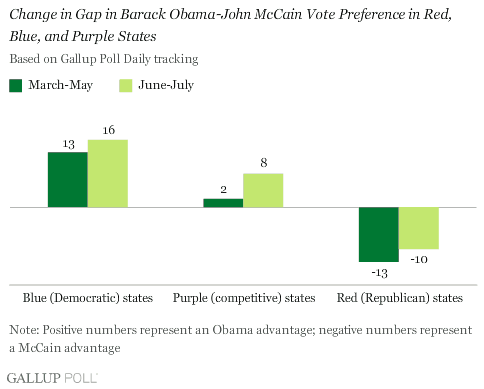
Prior to Obama's securing the Democratic nomination in early June, he and McCain were running even nationally, with each averaging 45% of the total vote in Gallup Poll Daily tracking from March through May. Since then, Obama has gained a slight upper hand, averaging a 3 percentage-point national advantage over McCain (46% to 43%) in June and July interviewing.
These results are based on data from tens of thousands of interviews with registered voters in all 50 states plus the District of Columbia, so the changes -- despite their relatively small size -- are statistically meaningful.
Obama's gains have come across the political and geographic spectrum, as he has improved his relative positioning versus McCain in "red states" (defined as those Republican George W. Bush won by 6 percentage points or more in 2004), "blue states" (those Democrat John Kerry won by 6 percentage points or more in 2004), and "purple states" (those in which the margin of victory for the winning candidate was less than 6 points).
While Obama has gained slightly in each of these state groupings, he has gained somewhat more in the most competitive states, seeing his lead expand in these by 6 points, as opposed to 3-point gains in the Obama-McCain gap in red and blue states. Since early June, he has averaged a 16-point lead over McCain in blue states and an 8-point lead in purple states, while trailing McCain by an average of 10 points in red states (McCain trails by only 3 points overall given the greater number of voters in red states).
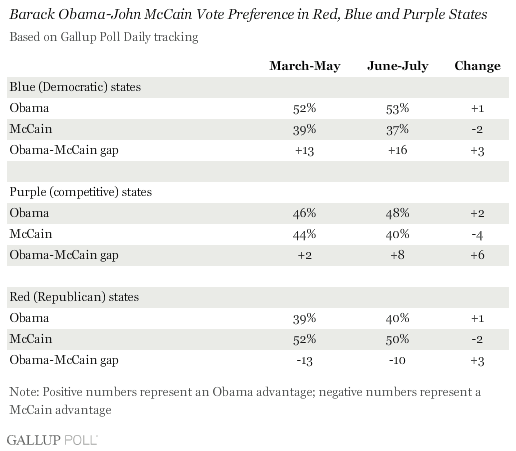
And while the changes in voter preferences have not been great, Obama has clearly established himself as the consistent leader in purple states since late May, whereas the two candidates were more competitive in these states prior to that.
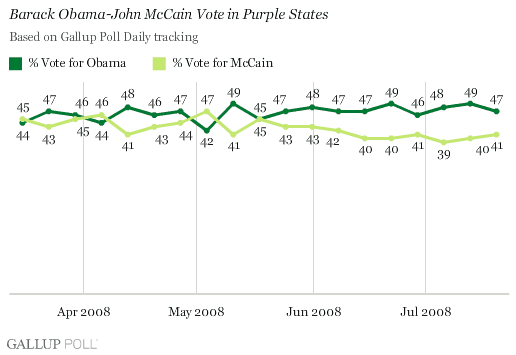
Meanwhile, McCain has always enjoyed a comfortable lead in red states while Obama has done the same in blue states.
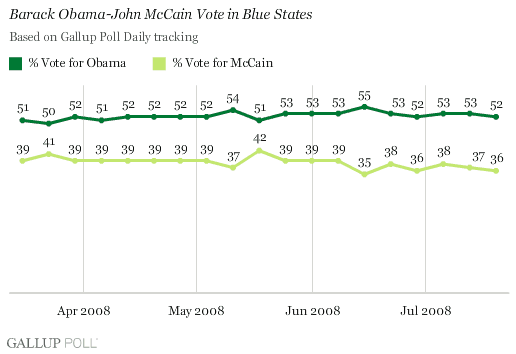
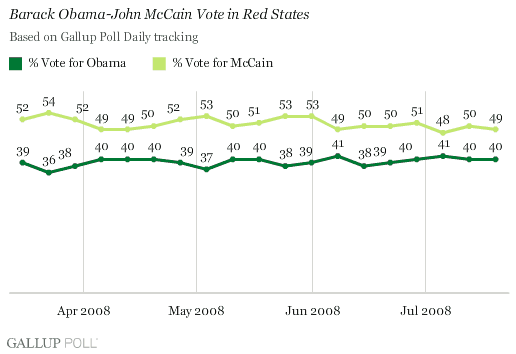
Despite his growing deficit in the competitive states, McCain has been able to remain close to Obama on the national level given that more voters reside in red states (40%) than in blue states (31%). Thus, while McCain would merely need to break even with Obama in the most competitive states in order to win (he could win even if he trails Obama by a couple of points in those states), Obama needs to have at least a modest advantage in purple states in order to win the popular vote. Thus, the key to watch over the remainder of the campaign is not whether Obama has the lead over McCain in these states, but by how much.
Of course, the winner of the actual election is determined by electoral votes. This analysis groups all competitive states together and assumes the better Obama does in the popular vote in these states, the better his chances of winning a greater share of these states and their electoral votes.
Survey Methods
For the Gallup Poll Daily tracking survey, Gallup is interviewing no fewer than 1,000 U.S. adults nationwide each day during 2008.
Results for March 7 through June 1 are based on telephone interviews with 71,175 national registered voters, aged 18 and older, including interviews with 26,229 registered voters in red states, 23,873 in blue states, and 21,078 in purple states. For results based on the total sample of national adults, one can say with 95% confidence that the maximum margin of sampling error is ±1 percentage point.
Results for June 2 through July 20 are based on telephone interviews with 39,603 national registered voters, aged 18 and older, including interviews with 14,548 registered voters in red states, 13,311 in blue states, and 11,744 in purple states. For results based on the total sample of national adults, one can say with 95% confidence that the maximum margin of sampling error is ±1 percentage point.
Interviews are conducted with respondents on land-line telephones (for respondents with a land-line telephone) and cellular phones (for respondents who are cell-phone only).
In addition to sampling error, question wording and practical difficulties in conducting surveys can introduce error or bias into the findings of public opinion polls.
To provide feedback or suggestions about how to improve Gallup.com, please e-mail feedback@gallup.com.
